| Final Statistics: Alex & Maz | Total distance: 93,550km |
| Furthest Point: Rotorua, NZ | Now settled in Sydney, Australia |
| Final Statistics: Martin | Total distance: 79,698km |
| Furthest Point: Hobart, Australia | Now settled in Bristol, UK |
China
|
| Arrive: | Tue 7th Mar 06 | Depart: | Tue 28th Mar 06 |
| Days: | 21 | Approx km: | 5300 |
| Capital: | Beijing | Currency: | Yuan (CNY) |
| Weekend: | Sat/Sun | Time Zone: | GMT +8 |
| Int. dial code: | +86 | Language: | Mandarin Chinese, Cantonese |
| Visa Required: | Yes | Religion: | Confucianist, Buddhist, Taoist |
| Side of road: | Right | Best time to visit: | Mar-Apr or Sept-Oct |
| Diesel Price: | US$ 0.43 | Activities: | Sightseeing, Wildlife, Ancient sites, Temples, Rafting, Caves |
Click here to see our mission statement in Chinese.
Diary Entry: 7th-21st March 2006 - Into the Dragon's Lair...
Diary Entry: 13th-27th March 2006 - Leaping Tigers but No Hidden Trouser Snakes
Photo Album for China
Country Highlights En Route
 Huanglong
Huanglong
Situated in the north-west of Sichaun Province, the Huanglong valley is made up of snow-capped peaks and the easternmost of all the Chinese glaciers. In addition to its mountain landscape, diverse forest ecosystems can be found, as well as spectacular limestone formations, waterfalls and hot springs. The area also has a population of endangered animals, including the giant panda and the Sichuan golden snub-nosed monkey.
 Mount Emei
Mount Emei
The first Buddhist temple in China was built here in Sichuan Province in the 1st century A.D. in the beautiful surroundings of the summit Mount Emei. The addition of other temples turned the site into one of Buddhism's holiest sites. Over the centuries, the cultural treasures grew in number. The most remarkable is the Giant Buddha of Leshan, carved out of a hillside in the 8th century and looking down on the confluence of three rivers. At 71 m high, it is the largest Buddha in the world.
 Three Parallel Rivers of Yunnan
Three Parallel Rivers of Yunnan
Consisting of eight geographical clusters of protected areas within the boundaries of the Three Parallel Rivers National Park, in the mountainous north-west of Yunnan Province, the 1.7 million hectare site features sections of the upper reaches of three of the great rivers of Asia: the Yangtze (Jinsha), Mekong and Salween run roughly parallel, north to south, through steep gorges which, in places, are 3,000 m deep and are bordered by glaciated peaks more than 6,000 m high.
 Old Town of Lijiang
Old Town of Lijiang
Perfectly adapted to the uneven topography of this key commercial and strategic site, has retained a historic townscape of high quality and authenticity. Its architecture is noteworthy for the blending of elements from several cultures that have come together over many centuries. Lijiang also possesses an ancient water-supply system of great complexity and ingenuity that still functions effectively today.
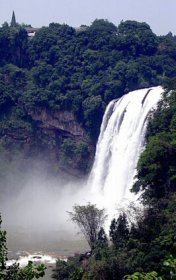 Huangguoshu Waterfalls
Huangguoshu Waterfalls
The Huangguoshu waterfalls are nothing short of massive and very impressive. Being the fourth biggest waterfall in the world, a water falling a distance of 85m makes quite a splash. There is a comfortable walking path around it and the surrounding park area.
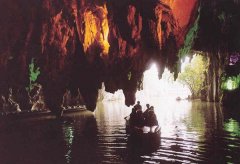 Longgong
Longgong
Dragon Palace, made up of a great number of karst caves stretching fifteen kilometers long, running through some twenty hills and connecting over ninety caves. An underground river flows through the caves, leaving some dry and some wet. The cave, 80-meter high and 50-meters at its widest point, contains some fantastic stalactites and is entered by boat from Tianci Lake. It is known as one of the spectacles of Asia.
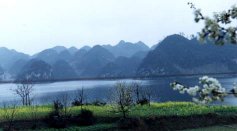 Baihua Lake
Baihua Lake
Situated 22 kilometres northwest of Guiyang on the upper reaches of Maotiao River, Baihua (Hundred-Flower) Lake is a vast expanse of clear water, whose surface is studded with 110 isles of varying sizes and shapes. Lusi (Egret) Isle to the east is a natural habitat of egretsThere are also limestone caves on some of the isles.
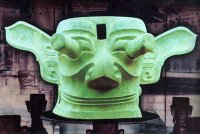 Sanxingdui
Sanxingdui
Recognized as one of the most important ancient remains in the world for its vast size, lengthy period and enriched cultural contents. The first Sanxingdui relics were discovered by a farmer in 1929 and excavation has continued ever since. During this period, generations of archaeologists have worked on the discovery and research of the Sanxingdui culture.
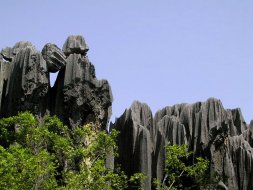 The Stone Forest
The Stone Forest
is a creation of prehistory. In the Permian period - roughly 270 million years ago - the earth flexed its muscles, caused an ocean to drain and the limestone seabed to rise up. 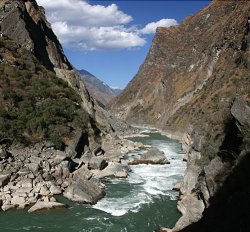 The wash of the receding waters, wind and acidic rains, all lent to the erosion of the limestone until only tall narrow karsts remained dotting the otherwise barren landscape
The wash of the receding waters, wind and acidic rains, all lent to the erosion of the limestone until only tall narrow karsts remained dotting the otherwise barren landscape
Tiger Leaping Gorge
One of the deepest chasms in the world, the Yangzi River flows 16km between the 3,900 metre tall mountains.
 Maling River Gorge
Maling River Gorge
A national scenic spot, the gorge is located 10 kilometres from Xingyi. From above, the gorge appears to be a bottomless crevice. Considered as "the spectacular crevice of the Yunnan-Guizhou Plateau", its numerous permanent waterfalls and seasonal waterfalls form a unique and gorgeous view. 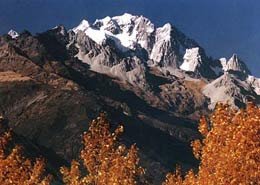 Tourists can raft down a 13.8-kilometre'section From Maling Town to Tianxing Bridge to enjoy the marvellous views and have a breathtaking experience.
Tourists can raft down a 13.8-kilometre'section From Maling Town to Tianxing Bridge to enjoy the marvellous views and have a breathtaking experience.
Mount Satseto
15km north of Lijiang and known to locals as Jade Dragon Snow Mountain, is the highest among the Himalayan peaks, rising 5,600 metres above the plains. It was first climbed in 1963, however access to the summit is now provided by cableway from the foot of the mountain to Yunshanping (Dragon Spruce Meadow). Two cableways for skiers are currently under construction.
| All content copyright � overland-underwater.com - please do not use without permission. |



 China
China 

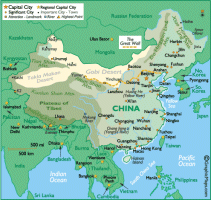


 Previous: Tibet
Previous: Tibet

